Native plants are an essential part of any local ecosystem. A native plant is a species that naturally originates in a particular area. There are many benefits to planting native plants in your garden. They’re typically easier to grow because they’re already adapted to the local climate and soil conditions. Native plants also provide food and shelter for local wildlife and help preserve the area’s natural ecosystem. Virginia is home to over 3,000 plant species, so there are many different species of flora to identify and learn more about in the state.
Native plants require less maintenance than non-native plants, which is good news for everyone! There are many ways that we can all help to support native plants in Virginia. One way is to plant them in our gardens and yards. Another way is to support businesses that sell native plants. And finally, we can spread the word to our friends and families about the importance of native plants!
1. Wild Geranium (Geranium maculatum)
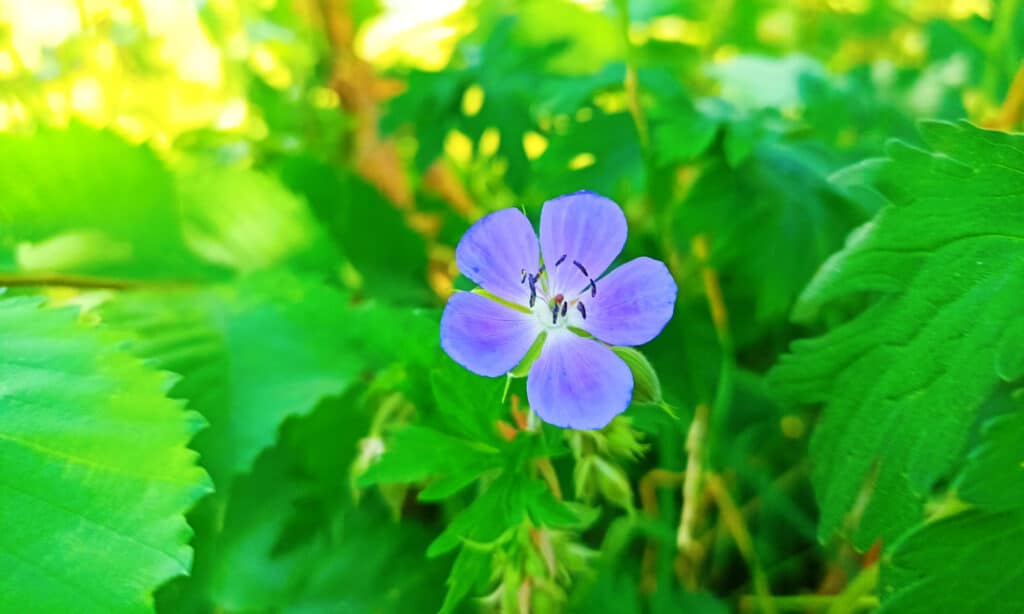
Wild geraniums are perfect additions to any rock garden or meadow.
©iStock.com/Natalila Paziura
The wild geranium plant, also known as the cranesbill and alumroot, can be found in woodlands, fields, and along roadsides throughout the state of Virginia.
Wild geranium is a member of the geranium family and is related to the common garden geranium. The wild variety blooms from April to June with pale pink or lavender flowers. The leaves of the plant are lobed and have a distinctive cranesbill shape, hence its other common name (cranesbill). This attractive perennial can grow to be 1 to 2 feet tall.
This geranium is a perfect addition to any rock garden or meadow, as its pale but beautiful colors will certainly brighten up any space. Plus, the wild geranium is a welcome sight for bees, butterflies, and beetles while acting as a deterrent for deer and rabbits!
2. Gray Beardtongue (Penstemon canescens)
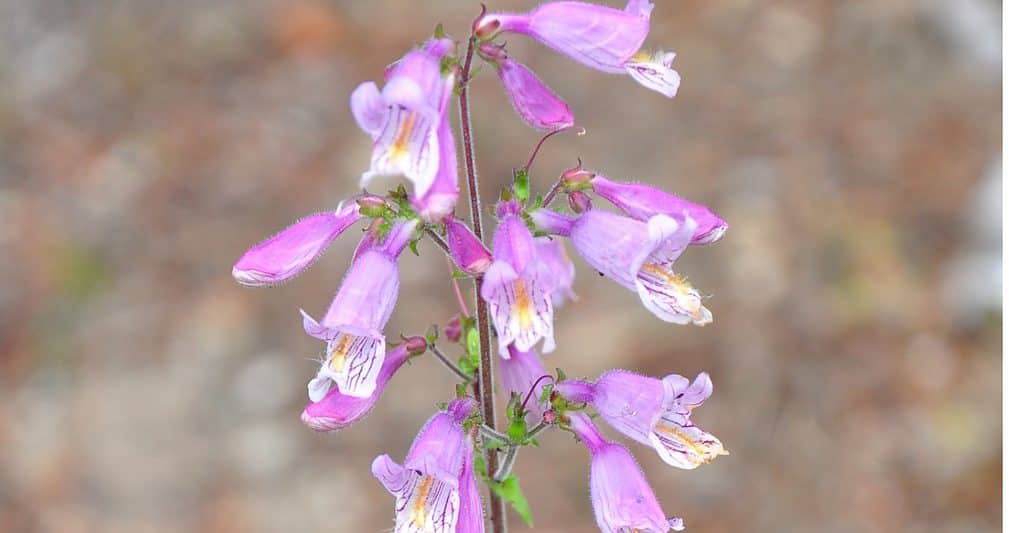
You can find the gray beardtongue in woodlands, forests, and mountain balds.
©iStock.com/rbiedermann
The gray beardtongue shares a family with plants such as the common plantain, the foxglove, and the speedwell. The genus name for gray beardtongue, Penstemon, comes from the Greek words Pente, meaning “five,” and Stemon, meaning “stamen.” This refers to the five stamens found on this plant’s flowers.
The gray beardtongue is native to Virginia and can be found in woodlands, forests, and mountain balds. This perennial typically blooms from May to July. It prefers to grow in partly shaded areas with dry, sandy soils. So, this plant is relatively low-maintenance and will survive even if you forget to water it every once in a while!
The flowers of this plant are tubular and have two lips. The flowers range from pale pink to white, with purple spots near the base of each lobe. Its stems are an interesting bright green with little hairs on the side. And this herb’s leaves are oblong-shaped, featuring some slight spikes, making this little plant seem a bit more menacing than it looks at first glance! The Gray Beardtongue can reach heights of up to 3 feet tall.
3. Black-Eyed Susan (Rudbeckia hirta)
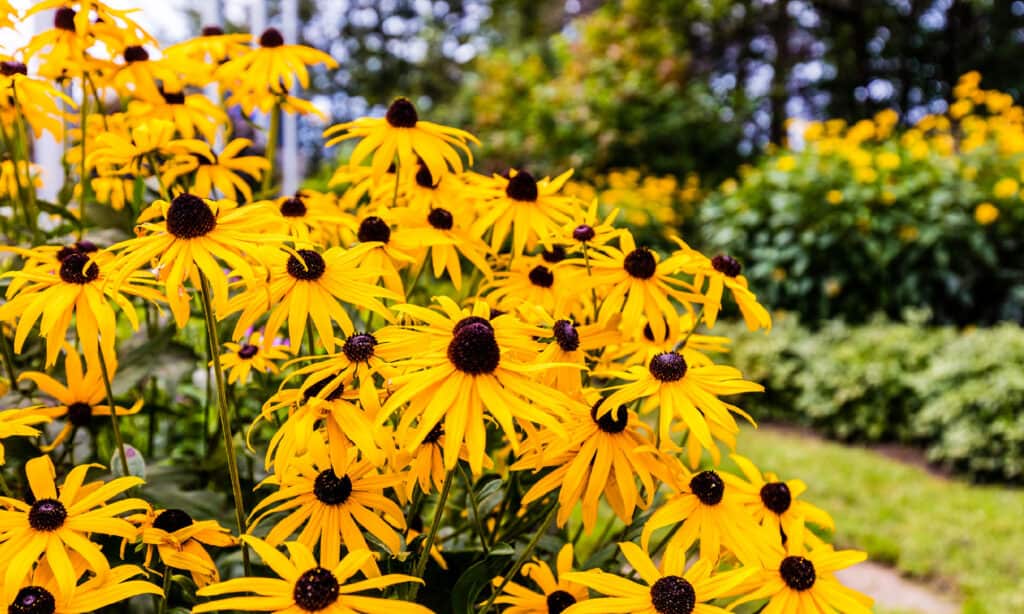
You can grow the black-eyed Susan plant easily.
©iStock.com/Dopeyden
The black-eyed Susan, also called Rudbeckia Hirta, is a flower found in many parts of the United States, including Virginia. In fact, it is probably one of the most recognizable plants in the USA.
This plant gets its name from its flower head’s dark brown or black dome-shaped center. The black-eyed Susan is a member of the daisy family and usually blooms between June and August. It is a perennial flowering plant that spreads its cheerful look across 48 of the states of the continental US. The black-eyed Susan has beautifully bright yellow and orange flowers with between 8 to 20 rays (or petals).
The black-eyed Susan plant is known for being ridiculously easy to grow and doesn’t require much maintenance, which is a plus if you’re new to gardening. For being such an easy plant to grow, this perennial can really blanket a particular landscape or garden with its striking colors. Since this plant blooms from early summer to the first frost, it really makes a statement.
The black-eyed Susan is also an excellent choice for gardeners looking for a plant that attracts bees and butterflies. The nectar from the flowers is one of the primary food sources for bees during late summer and early fall!
4. Butterfly Weed (Asclepias tuberosa)
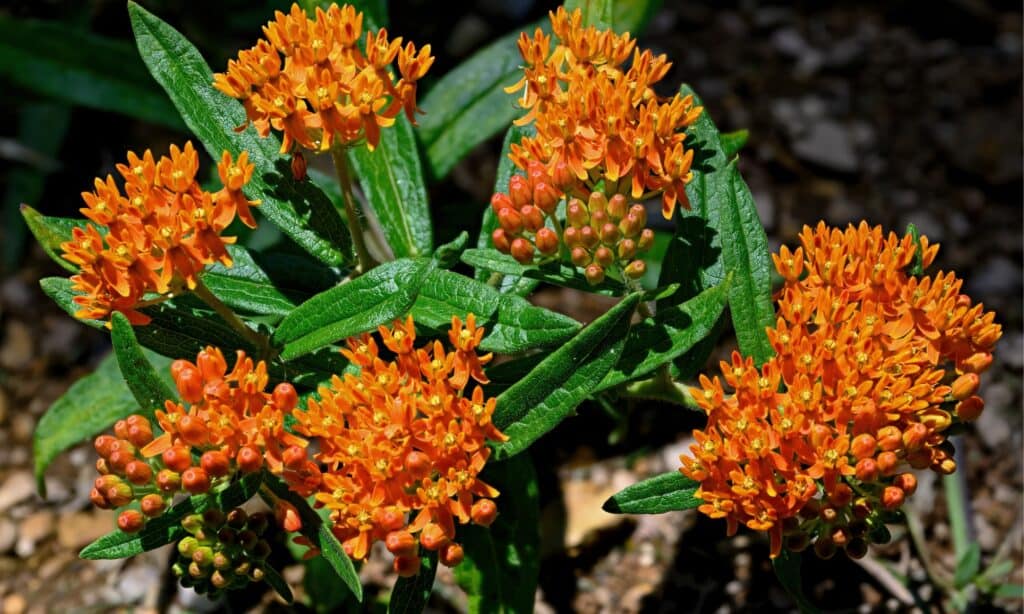
The butterfly weed has beautiful clusters of orange or yellow flowers that bloom all summer.
©iStock.com/McKinneMike
Virginia is home to two species of butterfly weed – Asclepias tuberosa and Asclepias incarnata. Both are gorgeous plants that attract butterflies, but A. tuberosa is more commonly found in the state.
The butterfly weed is a beautiful perennial milkweed bush that can be found in Virginia and all across eastern and southwestern America. It gets its name because it is a popular nectar source for butterflies! The tremendous amount of nectar from the flowers is especially appealing to them. So, if you want to attract some butterflies to your garden, look no further than the butterfly weed! It definitely helps that this is a low-maintenance plant as well.
The butterfly weed has beautiful clusters of orange or yellow flowers that bloom all summer. These attractive umbels, or flower clusters, can grow to be around 2 to 5 inches across, and these many umbels dot along with the entire bush. The butterfly weed’s leaves are stiff, sturdy, and lance-shaped; they are light yellow-green in color. This bush can grow to be around 1 to 2 feet tall and wide.
What’s even more fascinating about this plant is that it contains toxins that make it unpalatable to most animals – including humans. However, monarch butterflies are immune to these toxins and benefit from them. The toxins make the monarch butterfly less likely to be eaten by predators, thus helping them survive. It’s incredible how such a small plant can have such a significant impact on the ecosystem!
5. Wild Bergamot (Monarda Fistulosa)
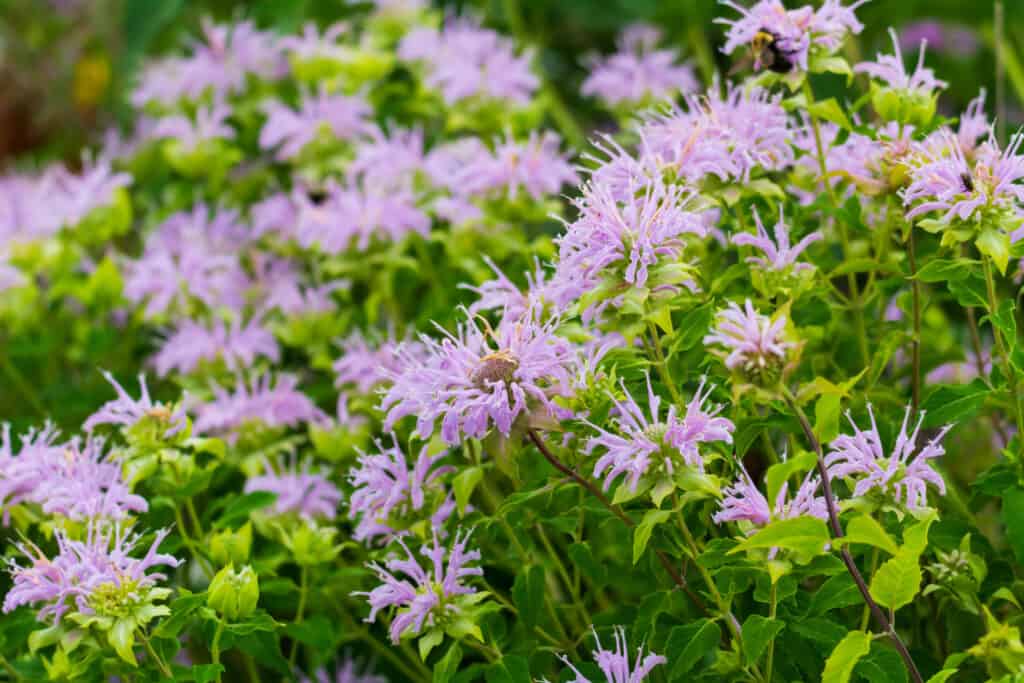
The wild bergamot blooms from June to September.
©James W. Thompson/Shutterstock.com
Wild bergamot, scientifically known as Monarda Fistulosa, can be found in woodlands, fields, and along roadsides throughout the state and even across the country. It is part of the mint family and is used as a medicinal plant as well as an ornamental one.
The wild bergamot blooms from June to September and produces purple or pink tubular flowers that are incredibly fragrant. These blooms are filled with nectar, making them a popular plant for butterflies, hummingbirds, and other pollinators. These flowers grow to be around 2 to 3 inches across, while the plant itself is approximately 2 to 4 feet tall when fully grown. The plant’s spread is almost as wide as it is tall.
There are various uses for the wild bergamot, which makes it an incredibly versatile plant. For example, the fragrant leaves of the wild bergamot plant have been used to make tea. In addition, the oil extracted from wild bergamot has been used in perfumes and cosmetics for centuries. And in Native American tradition, the wild bergamot was used as a remedy for colds, flu, and headaches.
Please note: A-Z Animals does not recommend plants or herbs for medicinal or health use. We present the following information for academic and historical purposes only.
6. Yellow Wild Indigo (Baptisia tinctoria)
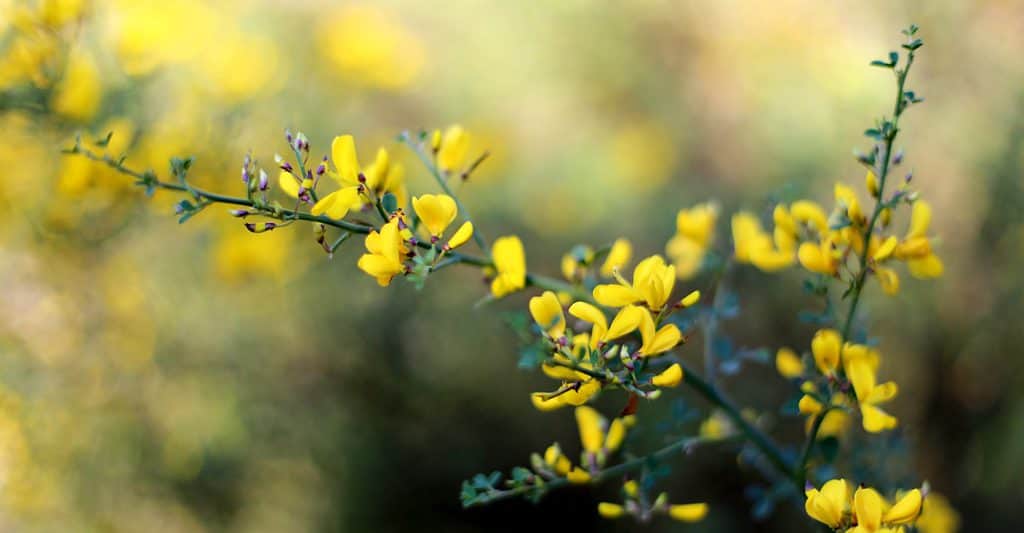
Yellow wild indigo leaves are favorite food sources for certain caterpillar species.
©iStock.com/Wirestock
The yellow wild indigo is a beautiful plant that blooms in late spring with bright yellow flowers; it is native to the eastern United States, including Virginia. It grows best in a full sun position with well-drained soil and can grow up to three feet tall. This plant is an excellent addition to any garden; bees and butterflies love its blooms! So, if you’re looking to attract these welcome visitors, look no further than the Baptisia Tinctoria.
The yellow wild indigo has silver-green leaves, each of which is divided into three smaller leaves, almost like a clover. The leaves are a favorite food source for certain caterpillar species. These yellow flowers grow to be up to 3 inches tall.
Although not the most impressive-looking plant, the yellow wild indigo has various uses. Native Americans used the roots of this plant to make a dye for their clothing, and the plants were also used medicinally for treating colds, flu, and stomachaches. Today, it is still used in natural dyeing processes.
7. White Oak (Quercus alba)
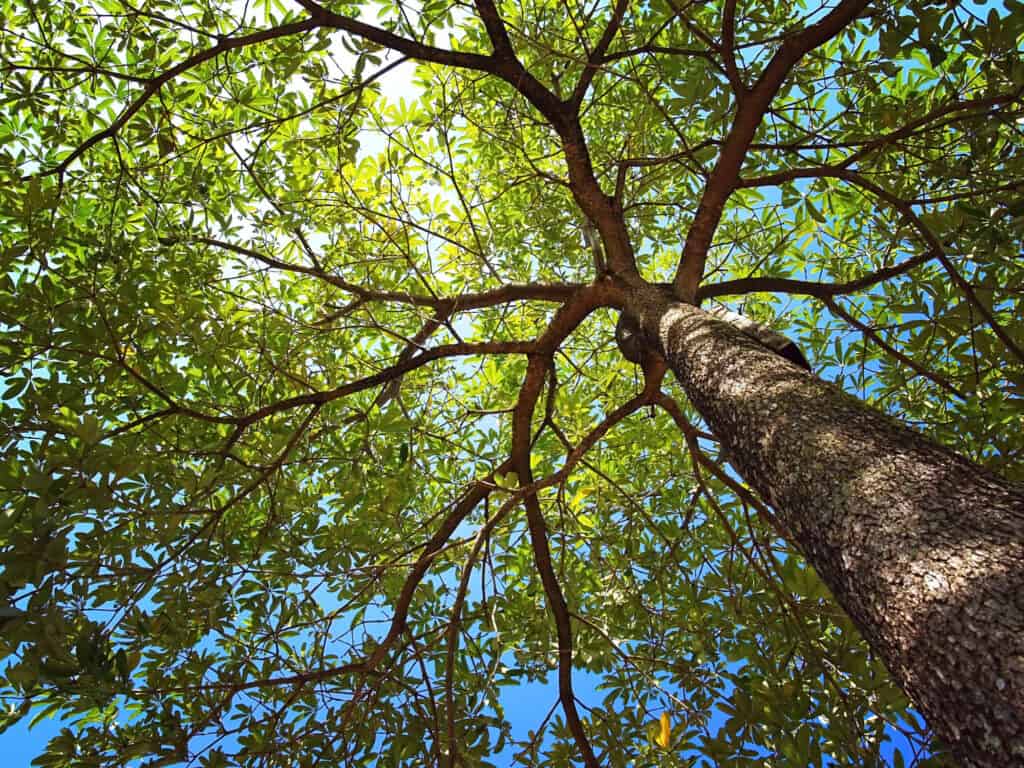
White oak trees have grayish-textured bark.
©Artorn Thongtukit/Shutterstock.com
The white oak is a beautiful and majestic tree that is considered by many to be the most noble American oak. This incredible plant can grow from 60 to 100 feet tall! It has strong rot and decay-resistant wood, making it a popular choice for furniture making and construction. The white Oak is also an important food source for wildlife, as its acorns are a favorite of squirrels, deer, and birds.
The white oak is a deciduous tree that features leaves with around 7 to 9 lobes. The leaves have a gorgeous pink hue in the spring, which then turns to dark green, and finally, the leaves turn a showstopping red in the fall months. The leaves of the White Oak are used as food by over 500 caterpillar species!
The White Oak tree also produces many acorns. The acorns of the White Oak are around 1 inch long, and they are a valuable and necessary food source for animals and birds in the area! One mature White Oak tree can produce 10,000 acorns in a season.
This magnificent tree has been revered by Native Americans for centuries and is still an essential part of Virginia’s history and culture today. The White Oak tree lives to 300 years on average but can even live to 600 years old!
8. Flowering Dogwood (Cornus florida)
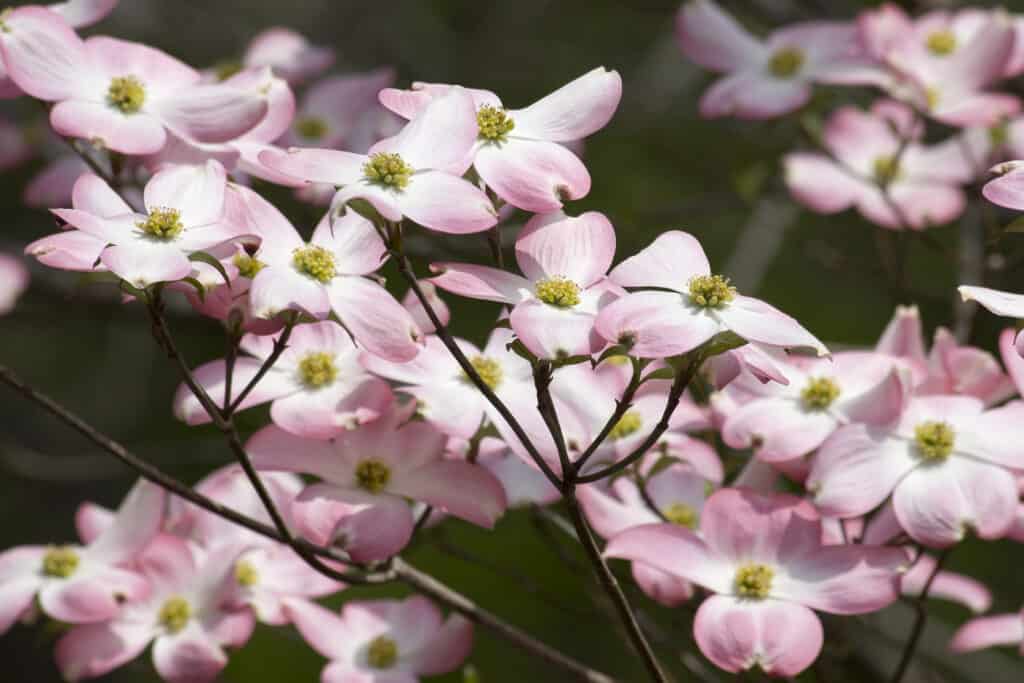
The flowering dogwood is also an important tree for people in Virginia.
©iStock.com/JillLang
The flowering dogwood is a deciduous tree native to Virginia and other eastern US states. It blooms in the springtime and has stunning umbels that are made up of around 20 tiny yellow-green flowers in the center. Surrounding the little flowers are four large bracts that are white in color. In other words, these umbels seemingly create one larger white flower, but the reality is that these are clusters of tiny yellow flowers in the middle that are surrounded by 1-inch-long white leaves. The flowering dogwood tree’s flowers are also a vital nectar source for bees and other pollinators! In the summer, the blossoms turn into bright red oval-shaped fruits, a treat for many bird species.
The tree leaves are also beautiful. These oval leaves start off a stunning green until they change color in the fall to a deep red. The flowering dogwood is an essential tree for wildlife in Virginia. Many birds and animals use the tree for shelter and food.
The flowering dogwood is also an important tree for people in Virginia. The tree’s wood is solid and can be used for furniture and other wood products. Native Americans once used this tree’s bark to make medicine too.
This flowering tree is also famous for landscaping because it is relatively easy to care for, and its branches provide good shade as they grow up to 30 feet tall. Take a walk through one of Virginia’s many parks or forests during the springtime; the flowering dogwood is truly a sight to behold!
Up Next:
- Virginia’s 5 best Bird Watching Spots This Summer
- Discover Virginia’s 3 Largest and Most Dangerous Snakes This Summer
- Discover the Fastest Animals in Virginia
- Discover 7 Incredible Places To See Fall Foliage in Virginia
The photo featured at the top of this post is © iStock.com/mzurawski
Thank you for reading! Have some feedback for us? Contact the AZ Animals editorial team.






